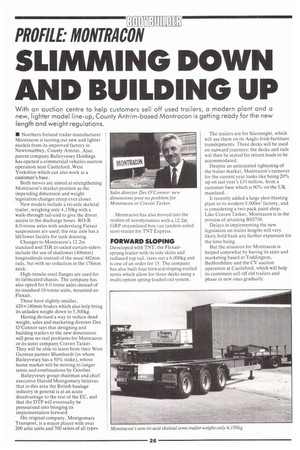SLIMMING DOWN AND BUILDING UP
Page 140

If you've noticed an error in this article please click here to report it so we can fix it.
• Northern Ireland trailer manufacturer Montracon is turning out new and lighter models from its improved factory in Newtonabbey, County Antrim. Also, parent company Balleyvesey Holdings has opened a commercial vehicles auction operation near Castleford, WestYorkshire which can also work at a customer's base.
Both moves are aimed at strengthening Montracon's market position as the impending dimension and weight legislation changes creep ever closer.
New models include a tri-axle skeletal trailer, weighing only 4,150kg with a walk-through tail-end to give the driver access to the discharge hoses. RO-R 8.0-tonne axles with underslung Flexair suspensions are used; the rear axle has a lift/lower facility for tank draining.
Changes to Montracon's 12.2m standard and TIR tri-axled curtain-siders include the use of shallower (406mm) longitudinals instead of the usual 482mm rails, but with no reduction in the 178mm neck.
High-tensile-steel flanges are used for its fabricated chassis. The company has also opted for 8.0 tonne axles instead of its standard 10-tonne units, mounted on Flexair.
These have slightly smaller, 420x 180mm brakes which also help bring its unladen weight down to 5,500kg.
Having devised a way to reduce dead weight, sales and marketing director Des O'Connor says that designing and building trailers to the new dimensions will pose no real problems for Montracon or its sister company Craven Tasker. They will be able to learn from their West German partner Blumhardt (in whom Balleyvesey has a 50% stake), whose home market will be moving to longer semis and combinations by October.
Balleyvesey group chairman and chief executive Harold Montgomery believes that in this area the British haulage industry in general is at an acute disadvantage to the rest of the EC, and that the DTP will eventually be pressurised into bringing its implementation forward.
His original company, Montgomary Transport, is a major player with over 200 artic units and 700 semis of all types. Montracon has also moved into the realms of aerodynamics with a 12.2m GRP streamlined box van tandem-axled semi-trailer for TNT Express.
Developed with TNT, the Flexairsprung trailer with its side skirts and radiused top rail, tares out a 6,000kg and is one of an order for 15. The company has also built four forward-sloping-roofed semis which allow for three decks using a multi-option spring-loaded rail system. The trailers are for Silentnight, which will use them on its Anglo-Irish furniture transhipments. Three decks will be used on outward journeys: the decks and rails will then be stored for return loads to be accommodated.
Despite an anticipated tightening of the trailer market, Montracon's turnover for the current year looks like being 20% up on last year's £10 million, from a customer base which is 90% on the UK mainland.
It recently added a large shot-blasting plant to its modern 5,000m2 factory, and is considering a two-pack paint shop. Like Craven Tasker, Montracon is in the process of attaining 855750.
Delays in implementing the new legislation on trailer lengths will very likely hold back any further expansion for the time being.
But the situation for Montracon is helped somewhat by having its sales and marketing based at Toddington, Bedfordshire and the CV auction operation at Castleford, which will help its customers sell off old trailers and phase in new ones gradually.






















































































































































